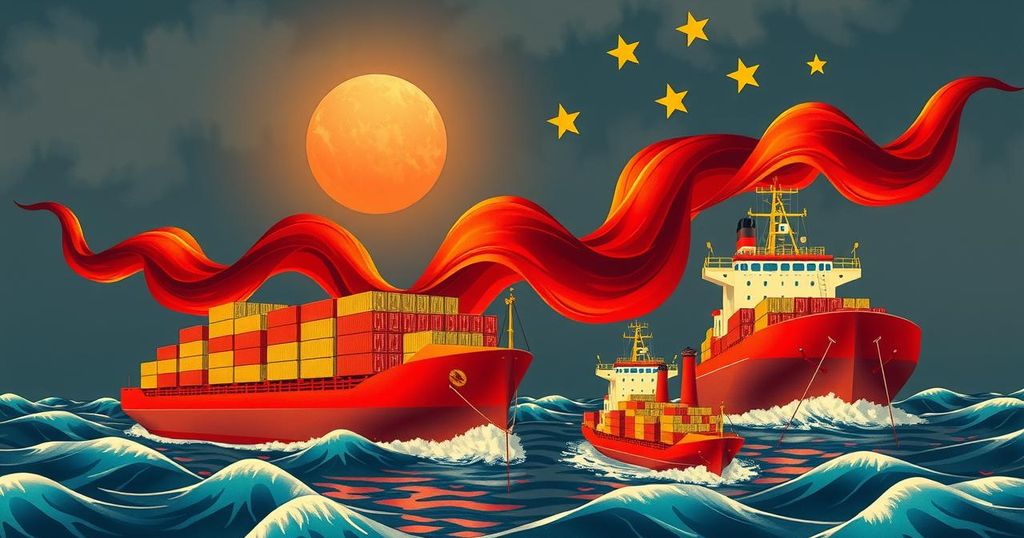China’s Defiance: From Collaboration to Tariff Warfare with Trump

China has transitioned from attempting to engage with Trump to a firm stance against U.S. tariffs, enacting a wartime posture among officials and seeking global support. This shift culminated in remarks invoking Mao’s defiance, highlighting China’s resolve not to yield amid rising tensions and trade hostilities with the U.S.
Following unsuccessful attempts to cultivate a favorable relationship with President Donald Trump, China has adopted a defiant stance regarding trade policies. It has mandated that foreign affairs and commerce officials cancel their vacations and maintain constant communication availability, reflecting a military-like posture in response to Trump’s tariffs. The Communist Party is actively influencing public sentiment by echoing the resolute message of former leader Mao Zedong, who asserted, “we will never yield.”
Beijing’s aggressive approach signifies a marked shift from its previous attempts to engage diplomatically with Trump’s administration. For several months, Chinese officials sought to establish open channels of communication aimed at preserving what they described as a mutually beneficial trading relationship. Optimistic Chinese analysts had hoped for a significant agreement encompassing trade and technology issues, yet those hopes have diminished as China resorts to retaliatory tariffs.
China’s strategy includes courting international allies to counter Trump’s tariffs, with outreach directed at nations affected by U.S. policies. Chinese diplomats have reached out to traditional U.S. allies in Europe and Asia, demanding cooperation against what it claims are unilateral trade aggressions by the U.S. The Chinese Foreign Ministry emphasized that the trade war originated from U.S. actions and insisted upon a dialogue rooted in equality and mutual respect.
President Trump has characterized the Chinese reaction as panicked, remarking that it reflects a significant miscalculation on their part. U.S. officials have expressed frustration with China’s failure to address a perceived trade imbalance, attributing it to longstanding issues in the global trading system. Trump’s recent tariffs have largely frozen trade between the two nations, pushing China to respond with restrictions on goods, services, and travel related to the U.S.
The initial months of Trump’s presidency exhibited a cordial tone; however, this quickly deteriorated as high-level communications faltered. Notably, President Trump has not confirmed any specific future meetings with Chinese leadership despite expressing openness to dialogue. Current communications between the two governments have reportedly stalled, with lower-tier officials remaining engaged without yielding any significant outcomes.
China’s officials have learned from past engagements during the trade conflict, developing a comprehensive retaliatory strategy that encompasses tariffs and exporting restrictions targeting U.S. interests. They have proceeded to announce cross-the-board tariffs even before the U.S. tariffs took effect, showcasing a rapid and unconventional response indicative of a shift in their operational methods.
Despite reports of an aggressive stance, some Chinese commentators have advocated for selective countermeasures rather than broad tariff increases. The Chinese government, recognizing the need to strengthen domestic economic resilience, has begun to promote consumer spending as an alternative growth strategy in light of the mounting pressures from tariffs. This shift is emblematic of a strategic pivot towards internal stabilization amidst external economic challenges.
Recently, during high-level meetings back in Beijing, China has coordinated its diplomatic responses and reached out to other nations under Trump’s tariff regime. Formal communications have outlined China’s position and called for a united front against unilateral pressures. However, these communications have also faced skepticism regarding China’s compliance with global trading norms.
To encapsulate its stance, China has turned to resonate populist calls for endurance, harkening back to historical rhetoric during contentious times in its past. The message remains clear: China asserts its resolve to “never yield” in the face of external economic pressures. Thus, the real struggle may lie not only in international negotiations but also within its own domestic landscape as it navigates new economic realities in the wake of changing U.S.-China relations.
In conclusion, China’s pivot from seeking a cooperative relationship with President Trump to adopting a confrontational stance marks a significant shift in its trade strategy. The government is actively rallying international support against U.S. tariffs while reinforcing its domestic economic measures. With strong rhetoric reminiscent of its historical leaders, China declares its readiness to face the challenges posed by the ongoing trade war. As both nations navigate these complexities, the implications for global trade and political alliances will remain vital areas for observation.
Original Source: www.usatoday.com







